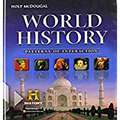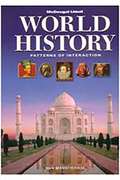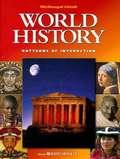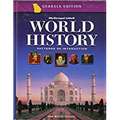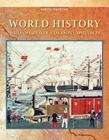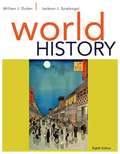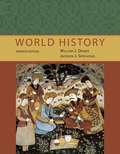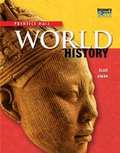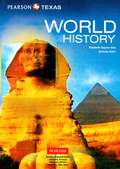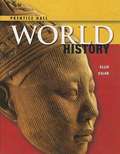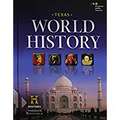- Table View
- List View
World History: Patterns of Interaction
by Roger B. Beck Linda Black Larry S. Krieger Phillip C. Naylor Dahia Ibo ShabakaBeginnings of Civilization, New Directions in Government and Society, An Age of Exchange and Encounter, Connecting Hemispheres, Absolutism to Revolution, Industrialism and the Race for Empire, The World at War, Perspectives on the Present.
World History: Patterns of Interaction
by Roger B. Beck Linda Black Larry S. Krieger Phillip C. Naylor Dahia Ibo ShabakaThis book pays special attention to eight significant and recurring themes. These themes are presented to show that from America, to Africa, to Asia, people are more alike than they realize.
World History: Patterns of Interaction
by Roger B. Beck Linda Black Larry S. Krieger Phillip C. Naylor Dahia Ibo ShabakaHistorical events are unique, they often are driven by similar, repeated forces. In telling the history of our world, this book pays special attention to eight significant and recurring themes. These themes are presented to show that from America, to Africa, to Asia, people are more alike than they realize. Throughout history humans have confronted similar obstacles, have struggled to achieve similar goals, and continually have striven to better themselves and the world around them.
World History: Patterns of Interaction
by Roger B. Beck Linda Black Larry S. Krieger Phillip C. Naylor Dahia Ibo ShabakaNIMAC-sourced textbook
World History: Patterns of Interaction
by Roger B. Beck Linda Black Larry S. Krieger Phillip C. Naylor Dahia Ibo ShabakaNIMAC-sourced textbook
World History: Patterns of Interaction
by Roger B. Beck Linda Black Larry S. Krieger Phillip C. Naylor [et al]Georgia Edition World History Textbook for Grade 10
World History: Patterns Of Civilization
by Burton F. BeersA textbook history of the world focusing on the development of various civilizations.
World History: Ancient Civilizations Through the Renaissance
by Stanley M. Burstein Richard Shek Kylene BeersNIMAC-sourced textbook
World History: Ancient Through Early Modern Times
by Douglas Carnine Carlos Cortés Kenneth CurtisNIMAC-sourced textbook
World History: Ancient Through Early Modern Times
by Douglas Carnine Carlos Cortés Kenneth CurtisNIMAC-sourced textbook
World History
by William J. Duiker Jackson J. SpielvogelNew edition of a study of world history from the first civilizations to 1800. Cuiker and Spielvogel (both professors emeritus of East Asian studies, The Pennsylvania State U.) balance a global approach with attention to the unique character and development of civilizations in divergent parts of the world. Beginning with the dawn of early civilizations and culminating with the French and American revolutions, they offer a synthesis of political, economic, social, religious, intellectual, cultural, and military history. Attractively formatted with color illustrations and boxed sections containing information on topics of special interest. Annotation c. Book News, Inc., Portland, OR (booknews.com)
World History
by William J. Duiker Jackson J. SpielvogelFrom the dawn of civilization to the modern dilemmas of nation building in Africa and the Middle East, WORLD HISTORY takes a fascinating look at the common challenges and experiences that unite the human past and inform the future. Authors William J. Duiker and Jackson J. Spielvogel's best-selling text uses colorful visuals, maps, and dramatic first-hand historical accounts to give readers a powerful perspective on the human experience over time. The easy-to-read narrative is organized around seven major themes (Science and Technology; Arts and Ideas; Family and Society; Politics and Government; Earth and the Environment; Religion and Philosophy; and, Interaction and Exchange), important to all cultures from all time periods, to help readers understand the course of world history and make connections across chapters.
World History
by Elisabeth Gaynor Ellis Anthony EslerDeveloped specifically for high school global history programs, this text covers world history from the beginnings of human civilization to the present.
World History: Modern Student Edition
by Elisabeth Gaynor Ellis Anthony EslerNIMAC-sourced textbook
World History: The Modern World, California
by Elisabeth Gaynor Ellis Anthony EslerNIMAC-sourced textbook
World History
by Elisabeth Gaynor Ellis Anthony EslerDeveloped specifically to be used in the first part of a two-year global history course, this text covers world history through the Enlightenment period.
World History: Connections To Today
by Elisabeth Gaynor Ellis Anthony Esler Burton F. BeersA book that can be used as a tool to master world history.
World History: Connections to Today, The Modern Era
by Elisabeth Gaynor Ellis Anthony Esler Burton F. BeersThis book makes it easy to figure out what you really need to know about world history. Each section starts with Reading Focus questions that point out the most important ideas in that section. Case Studies on Contemporary Issues provide hands-on, project-based examination of key issues in the world today.
World History: The Modern Era
by Elisabeth Gaynor Ellis Anthony Esler Kathy SwanNIMAC-sourced textbook
World History: Continuity and Change
by William Travis Hanes Holt Rinehart Winston StaffWorld History: Continuity and Change presents historical information from the perspective of three key ideas fundamental to human history throughout the world. These ideas provide a basis for analyzing and evaluating past events. The first key idea is that civilization resulted from individual and group efforts to survive by adapting to the physical environment, adopting new behaviors if necessary as the environment itself changed. The second key idea is that as self-aware beings, humans try to ensure not only their physical well-being but also their emotional and spiritual well-being. The third key idea is that the more flexible human beings are in responding to changing circumstances, the more likely they are to survive.
